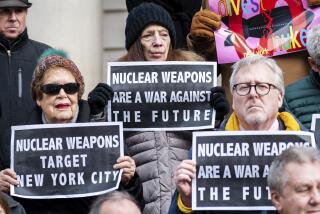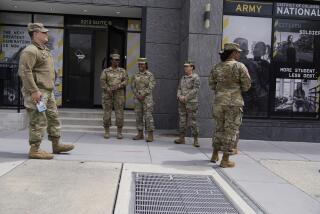Rumsfeld Sees No Need to Increase the Size of the Armed Forces
- Share via
WASHINGTON — Despite growing strains on U.S. forces, Defense Secretary Donald H. Rumsfeld insisted Tuesday that the Pentagon needs to exhaust every alternative before asking Congress to increase the overall size of the active-duty military force.
At a Pentagon briefing, Rumsfeld argued that the armed services can shift some tasks now handled by the military to private contractors or federal civilian employees, move part of the burden to allied armies, and find ways to rely more on labor-saving weapons technology.
“The way to get the right number is not, the first time you see a spike in activity, as we do right now in Iraq, to immediately decide, ‘Well, the solution’s to increase end strength,’ ” he said.
Rumsfeld’s comments came as Congress and the Pentagon debate whether the military is big enough to handle the global war on “rogue” states and terrorists that has forced the Army to deploy 21 of its 33 combat brigades overseas. Of the remaining Army brigades, most are awaiting new assignments abroad, refilling their ranks or on standby for service in other possible crises.
Some senior Army officials, pointing to the strains on the top war-fighting units, have suggested in recent weeks that the services might soon be asking Pentagon officials and Congress to increase the size of the force.
In his confirmation testimony last week, the new Army Chief of staff, Gen. Peter Schoomaker, said he needed to assess the Army’s troop needs.
“But I’m going to take a little risk here and I’m going to tell you that, you know, intuitively, I think we need more people. I mean, it’s that simple,” he said.
Some lawmakers from both parties have prodded the Pentagon to acknowledge its needs and to quickly ask for an expansion, so that training of new forces can begin.
Rumsfeld, however, insisted Tuesday that Schoomaker’s comments should not be interpreted to mean that the new chief believes more troops are needed. The Defense secretary said that while he maintains an open mind on the issue, a Pentagon review now underway has so far not shown that the military has done all it can to find other ways to solve the problem.
“At the moment, I don’t believe that anyone that I’ve talked to has evidence that argues that we have done those kinds of things sufficiently effectively that one could make a case for increasing end strength,” or total force size, Rumsfeld said.
He said Marine Corps Gen. Peter Pace, vice chairman of the Joint Chiefs of Staff, is heading a committee that is investigating whether the military is large enough to handle its obligations in Iraq, Afghanistan, Kosovo, the Sinai peninsula and South Korea. “Thus far, the analysis that’s been done by Pete Pace and his people indicate that we’re fine,” Rumsfeld said.
He insisted that there are many ways the Pentagon can ease the burden.
The military can streamline its procedures for rotating troops overseas, he said. It can continue to reduce U.S. forces abroad -- in the Balkans, for instance -- and can rely more on Iraqis to handle policing and military actions in their country.
Rumsfeld noted that some weapon systems being planned, such as Navy ships, use only a fraction of the men and women they have required in the past. And he said he had been told that civilian employees could handle up to 380,000 of the jobs currently handled by active duty military.
The military needs to be “respectful of the taxpayers’ dollars,” Rumsfeld said.
Some analysts, however, maintain that while Rumsfeld’s objectives are worthy, it will not be possible to do all the military now needs to do without making the first sizable increase in force size since the 1980s.
Michael O’Hanlon, a Brookings Institution defense analyst, said the problem was best illustrated by the burden on the military’s best combat units.
He said the 3rd Infantry Division may need to return to Iraq in another year to relieve the units that will soon provide its relief.
“This distills the whole problem simply: The last thing you want to do is to send back the people who’ve already been there ... it’s just too soon,” O’Hanlon said.
The analyst said Rumsfeld deserved praise for his efforts, but noted the Defense secretary has now had 2 1/2 years to pursue efficiencies, and “there haven’t been that many breakthroughs.”
O’Hanlon said the Pentagon would ultimately be required to increase its 1.4 million active-duty troops by 20,000 to 40,000, which he described as only a slight increase. At the end of the Cold War, there were about 2.1 million active-duty troops.
Also Tuesday, Army Vice Chief of Staff Gen. John Keane told reporters that there was “no doubt” that the military needs more infantry, military police and members of chemical- and biological-warfare teams.
But he stopped short of saying that the force size needed to be increased, saying it was necessary to first gauge how many military jobs could be transferred to civilians.
More to Read
Sign up for Essential California
The most important California stories and recommendations in your inbox every morning.
You may occasionally receive promotional content from the Los Angeles Times.











